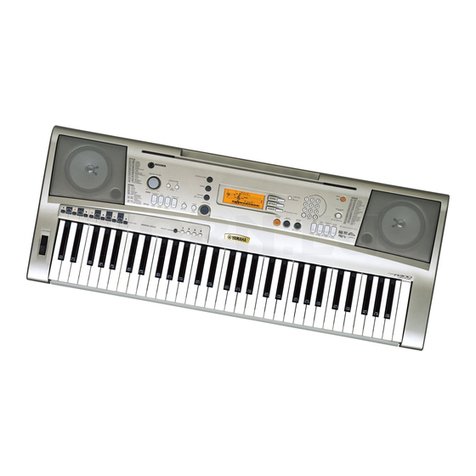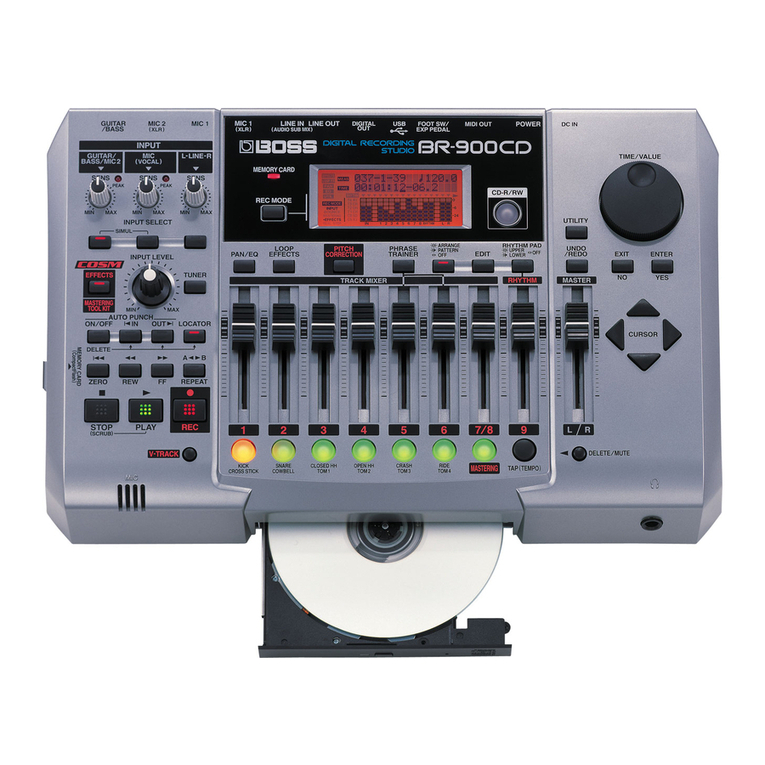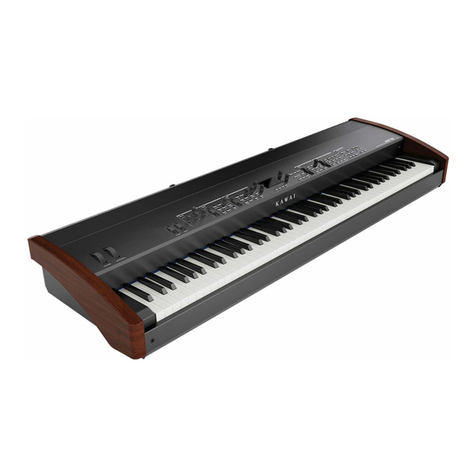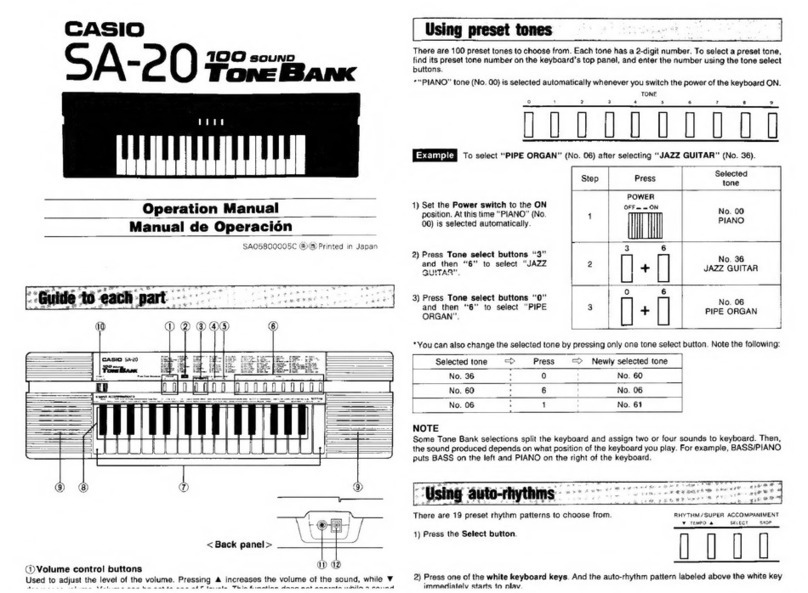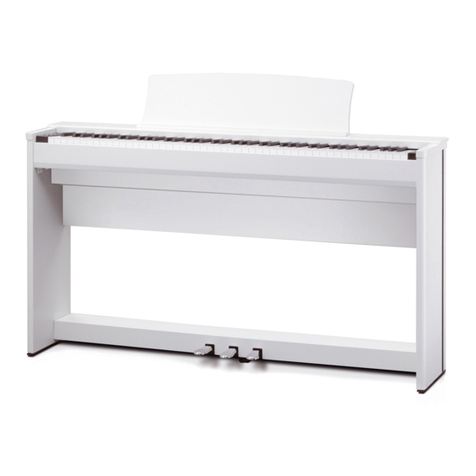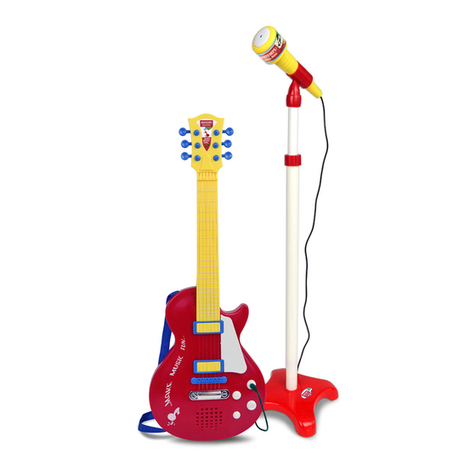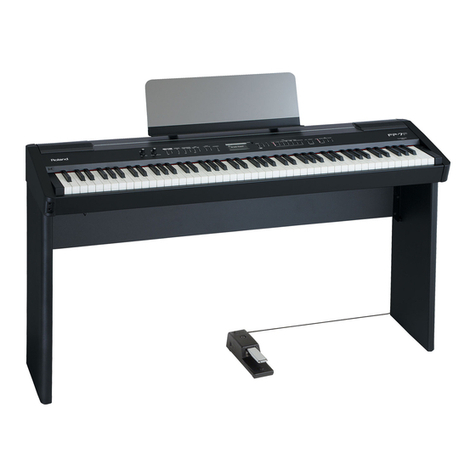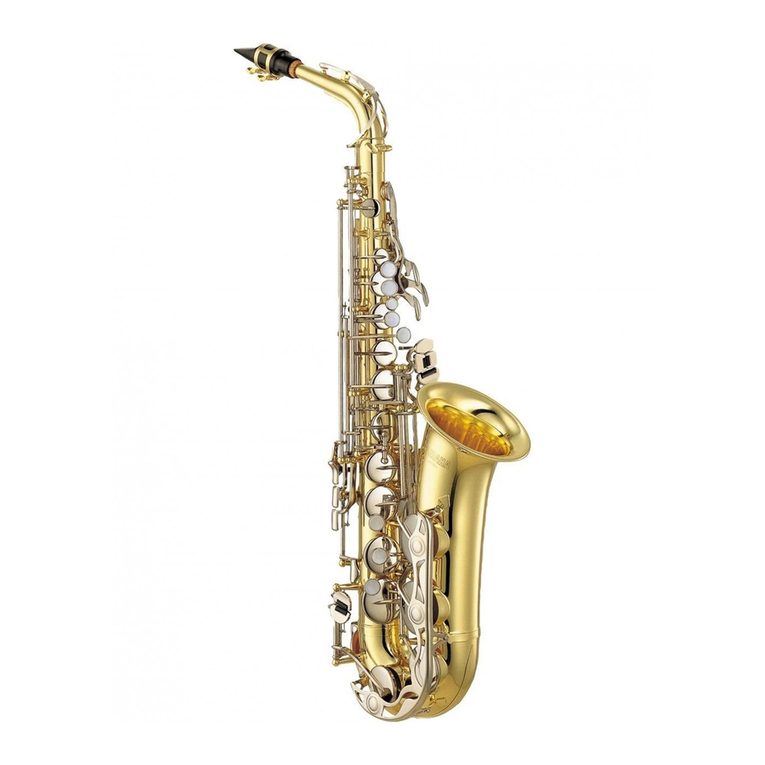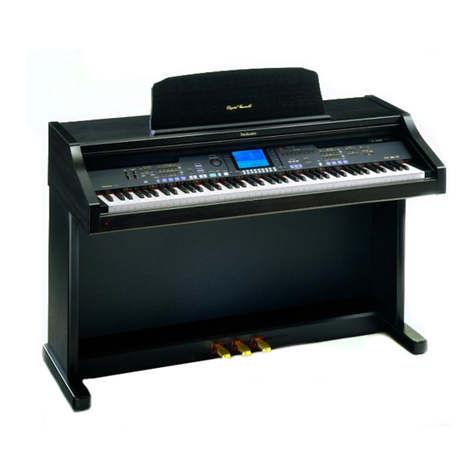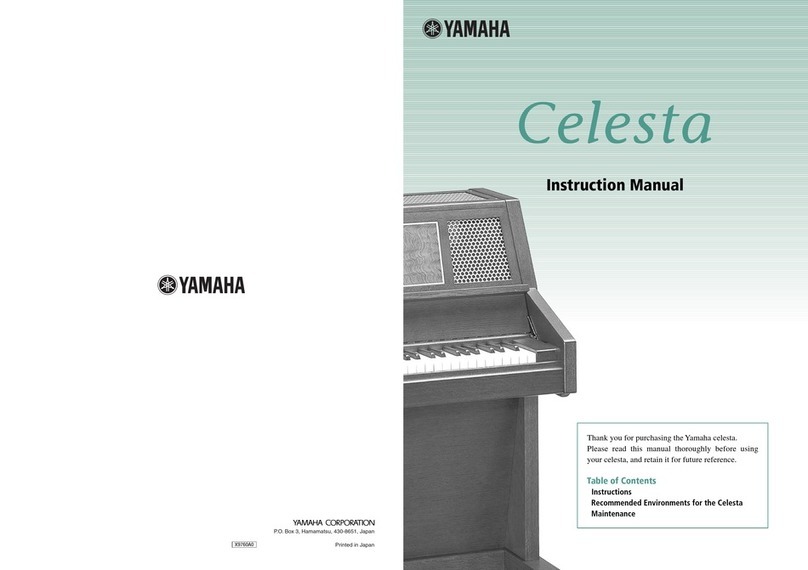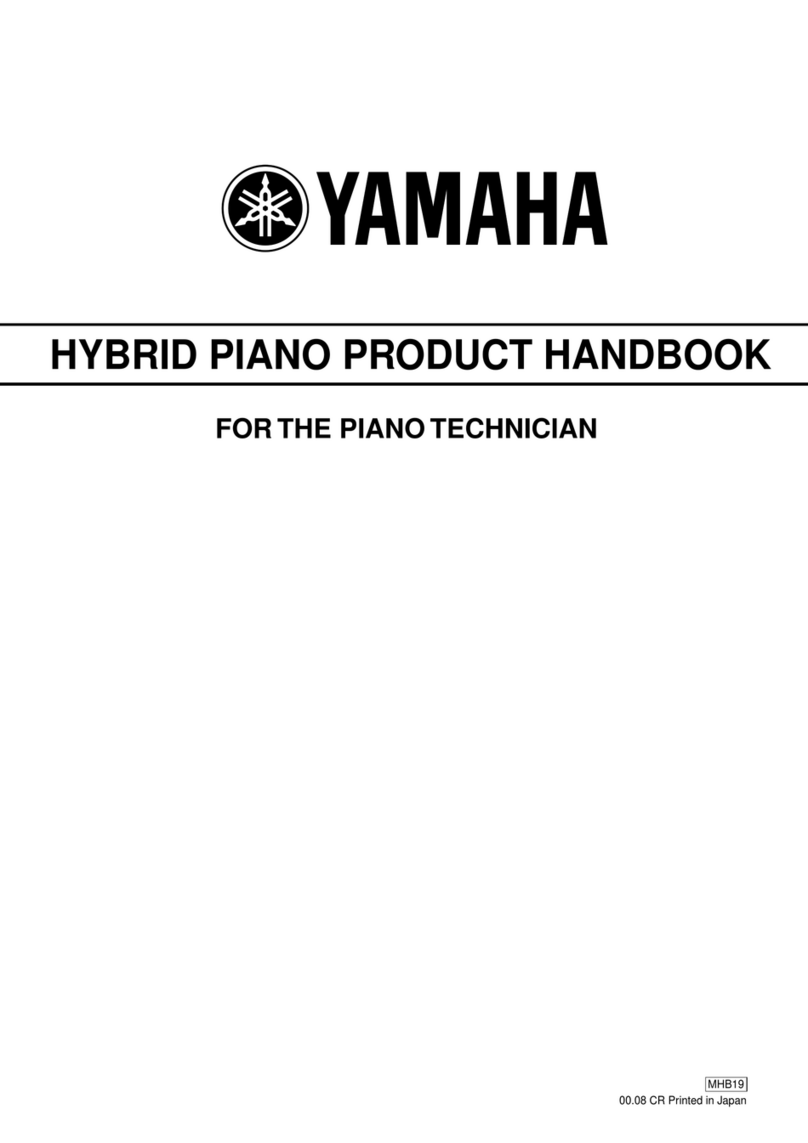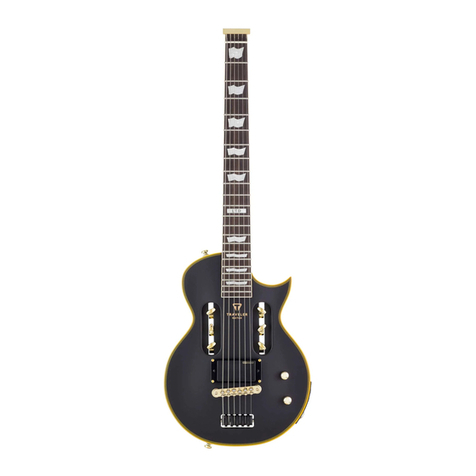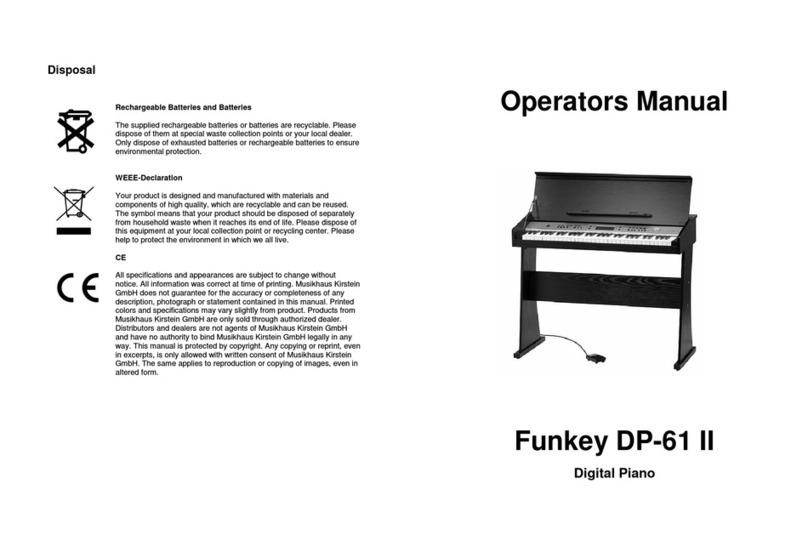KAWA 350 User manual

Model
350
Owner’s
Manual

Thank
you
for
purchasing
a
Kawai
Digital
Piano!
The
Kawai
digital
piano
model
350
is
a
revolu-
tionary
new
keyboard
instrument
that
combines
the
latest
in
electronic
advances
with
traditional
craftsmanship
inherited
from
Kawaji's
many
years
of
experience
in
building
fine
pianos.
Its
wooden
keys
provide
the
touch
response
and
full
dynamic
range
required
for
a
superb
performance
on
the
piano,
harpsichord,
organ,
and
other
instrument
presets.
Industry-Standard
MIDI
(Musical
Instru-
ment
Digital
Interface)
jacks
are
included
which
allow
you
to
play
other
electronic
instruments
at
the
same
time
—
opening
a
whole
new
world
of
musical
possibilities.
This
Owner’s
Manual
contains
valuable
information
that
will
help
you
make
full
use
of
this
instrument’s
many
capabilities.
Read
it
carefully
and
keep
it
handy
for
future
reference.
|
IMPORTANT
NOTES
|
e
Power
Supply
Use
only
the
voltage
appearing
on
the
plate
next
to
the
power
cord
(Rear
Panel).
Incorrect
voltage
presents
a
shock
hazard
and
wil!
also
damage
the
instrument's
delicate
elec-
tronic
circuitry.
e
Electrical
Noise
Keep
the
instrument
away
from
electrical
motors,
neon
signs,
fluorescent
light
fixtures,
and
other
sources
of
electrical
noise.
®
Power
Cord
Do
not
touch
the
power
plug
with
wet
hands.
There
is
a
risk
of
electrical
shock.
Treat
the
power
cord with
care
as
well.
Stepping
on
or
trip-
ping
over
it
can
break
or
short-circuit
the
wire
inside.
e
Repairs
and
Alterations
Never
attempt
to
remove
or
modify
the
piano’s
circuitry.
There
is
a
significant
shock
hazard
and
there
are
no
user
servicable
parts.
If
you
think
something
is
broken,
consult
your
nearest
authorized
Kawai
dealer.
LY
I
¡E
e
After
Use
Always
turn
the
power
off
when
the
instrument
is
not
in
use,
Leaving
the
piano
on
for
extended
periods
can
lead
to
serious
problems.

Table
of
Contents
Ø
Basic
Controls
......................
1
MBasic
Operation
....................
3
Hi
Advanced
Features.................
5
1)
MIDI
Interface...................
5
2)
TUNING
rara
9
3)
Temperaments..................
10
4)
Changing
the
SPLIT
Point
MSpecifications......................
11

MBasic
Controls
=
Front
Panel
POWER
VOLUME
1
POWER
switch
O O
Y
O
O
O O
oO
O
09684
guauoaa
Ea
HARPSI-
VIBRA-
FULL
JAZZ
PIANO PIANO
E-PIANO E-PIANO
CHORD
PHONE
ORGAN ORGAN
1
TREMOLO
CHORUS
ENSEMBLE ENSEMBLE
SPLIT
DUAL
DUAL/SPLIT
BALANCE
cI
Ce)
E
min
1612411186
max
mellow
A
bright
BRILLIANCE
2
VOLUME
control
3
BRILLIANCE
control
O O
O
O
Co
uo
oe)
y
BRASS
STRING
left
PPE
LAI
BS
l
right
TRANSPOSE
|
———
|
|
|
|
4
Tone
selector
switches
5
Effect
switches
6
7
8
9
1
POWER
2
VOLUME
Move
the
volume
slider
to
the
right
to
increase
the
instru-
ment's
volume.
Move
the
slider
to
the
left
to
decrease
the
volume.
3
BRILLIANCE
contro}
This
slider
controls
the
brilliance,
or
clarity,
of
the
sound.
Shifting
it
to
the
left
produces
a
rich,
mellow
sound;
shifting
it
to
the
right,
a
bright,
clear
sound.
The
center
position
corresponds
to
the
instrument's
normal
tone.
4
TONE
SELECTORS
Select
the
desired
instrument
by
pressing
the
appropriate
switch,
5
EFFECTS
These
functions
cause
the
output
to
become
more
animated
(CHORUS)
or
fluctuate
(TREMOLO).
6
SPLIT
switch
Pressing
this
switch
splits
the
keyboard
into
an
upper
and
lower
half,
each
with
different
tone
colors.
When
the
function
is
first
activated,
the
keyboard
is
split
at
the
point
marked
with
a
triangle
on
the
front
panel,
but
this
point
is
changeable.
For
the
procedure,
see
“Changing
the
SPLIT
point”.
7
DUAL
LED
Simultaneously
pressing
two
tone
selector
switches
lights
this
DUAL
LED
and
activates
the
DUAL
mode
of
operation,
in
which
the
piano
simultaneously
uses
two
tones
instead
of
just
one.
Press
a
single
tone
selector
switch
to
cancel.
8
DUAL/SPLIT
BALANCE
control
This
slider
controls
the
relative
loudness
of
the
two
voices
used
in
the
SPLIT
and
DUAL
modes.
Shifting
it
to
the
right
in
the
SPLIT
mode
makes
the
UPPER
keyboard
louder.
For
the
DUAL
mode,
it is
the
rightmost
preset
of
the
pair
that
becomes
louder.
=
Example
The
PIANO
1
selector
is
to
the
left
of
VIBE.
If
they
are
being
|
used
together
in
the
DUAL
mode,
shifting
the
slider
to
the
left
makes
the
PIANO
1
tone
louder.
Shifting
it
to
the
right
makes
the
VIBE
tone
louder.
9
FRANSPOSE
switch
The
TRANSPOSE
function
automatically
transposes
the
entire
keyboard
to
a
different
key.
For
example,
after
changing
the
transposition
to
the
key
of
E,
playing
a
C
scale
would
actually
sound
as
an
E
scale.
Changing
keys
is
as
easy
as
holding
down
this
switch
and
selecting
the
key
from
the
1-octave
range
marked
on
the
front
panel.
The
LED
next
to
the
switch
remains
lit
for
all
keys
except
C,
the
standard.
Note:
Pressing
and
then
releasing
the
TRANSPOSE
key
returns
the
piano
to
the
key
of
C
(No
transposition).

=
Rear
Panel
SOFT
DAMPER
THRU
200
6866
os
PEDAL
a:
ae
1
Pedal
control
jacks
|
MIDI
interface
jacks
1
PEDAL
These
jacks
are
used
to
connect
the
damper
and
soft
pedals.
2
MIDI
These
jacks
allow
communication
with
other
gear
equipped
with
MIDI.
IN
Accepts
MID!
data
from
other
instruments.
OUT
Transmits
MIDI
data
to
other
instruments.
THRU
Retransmits
all
MIDI
data
coming
into
the
MIDI
IN
jack
(for
use
in
a
chain
of
MIDI
devices).
3
EXPRESSION
pedal
This
jack
is
for
connecting
an
expression
pedal.
The
piano
also
adds
this
effect
to
the
signal
received
through
the
LINE
IN
jack,
4
Line
input
jacks
3
L/MGNO
L/MONO
¡O
II
nn
5
EXPRESSION
PEDAL
LINE
OUT
5
Line
output
jacks
4
LINE
IN
These
jacks
connect
two
channels
of
output
from
other
electronic
instruments
to
the
piano’s
speaker.
Use
the
L/
MONO
jack
when
using
only
one
input.
Note:
This
input
bypasses
the
piano’s
VOLUME
control.
To
adjust
the
balance,
you
must
use
the
output
volume
controls
on
the
individual
instruments.
The
two-position
switch
adjusts
the
LINE
IN
jack
sensitivity
to
match
the
source:
Low
for
strong
inputs
and
High
for
weak
ones.
5
LINE
OUT
These
jacks
provide
stereo
output
to
amplifiers,
stereo
systems,
tape
recorders,
or
similar
equipment.
The
two-position
switch
to
the
right
allows
you
to
adjust
the
output
level
to
High
(H)
or
Low
(L)
to
match
the
input
impedance
of
the
other
equip-
ment.
Use
the
L/MONO
jack
when
using
only
one
output.

WE
Basic
Operation
1
Basic
Operation
o
Turn
on
the
power.
When
the
power
is
first
applied,
the
LED
next
to
the
PIANO
1
switch
in
the
tone
selector
section
lights.
E3
POWER
D
Adjust
the
volume.
Sound
a
note
on
the
keyboard
and
adjust
the
volume.
(Moving
the
slider
to
the
right
raises
the
volume;
moving
it
to
the
left
lowers
it}.
Q=
min
IAAIITFAITEE
max
VOLUME
@)
Choose
a
tone
color
Pressing
a
tone
selector
switch
automatically
changes
the
tone
of
the
piano.
The
LED
next
to
it
lights
to
indicate
which
tone
is
currently
in
effect.
DUAL
operation
=
Procedure
Simultaneously
press
two
tone
selector
switches
to
achieve
two
tone
colors
at
once
and
light
the
DUAL
LED.
Notes:
e
Pressing
such
a
combination
also
halves
the
number
of
simultaneous
voices
available
to
eight.
e
Pressing
another
pair
changes
the
combination.
e
To
cancel
and
return
to
normal
operation,
press
a
single
tone
selector
switch.
SPLIT
operation
This
operation
splits
the
keyboard
into
an
upper
and
lower
half
with
different
tone
colors.
The
LED
for
the
UPPER
keyboard
tone
color
glows
continuously;
the
one
for
the
LOWER
keyboard
flashes.
=
Procedure
Press
the
SPLIT
switch
so
that
the
LED
next
to
it
lights.
Press
a
tone
selector
to
change
the
UPPER
tone
color.
Hold
down
the
SPLIT
switch
and
press
a
tone
selector
to
change
the
LOWER
tone
color.
Adjust
the
relative
loudness
of
the
two
tone
colors
with
the
DUAL/SPLIT
BALANCE
control.
Notes:
e
When
the
function
is
first
activated,
the
keyboard
is
split
at
the
point
marked
with
a
triangle
on
the
front
panel,
and
the
LOWER
keyboard
assumes
the
STRING
ENSEMBLE
tone
color.
e
The
LOWER
tone
color
specification
remains
in
effect
until
the
power
is
removed
or
the
tone
color
is
changed.
e
Switching
from
DUAL
operation
to
SPLIT
operation
makes
the
UPPER
keyboard
assume
the
right
tone
color
and
the
LOWER
assume
the
STRING
ENSEMBLE
or
the
tone
you
chose
for
the
LOWER
tone
color.
e
You
must
turn
the
SPLIT
operation
off
before
you
can
return
to
DUAL
operation.
.
To
change
the
SPLIT
point,
see
“Changing
the
SPLIT
point”,
SUYA
OO
O
70°
O
O
OO
O
O
oO
O
oO
CICICICIJCICICICI
A
a
HARPSI.
VIBRA
FULL
JAZZ
BRASS
STRING
PIANO
PIANO
E-PIANO
E
CHORD
PHONE
ORGAN
ORGAN
TREMOLO
CHORUS
ENSEMBLE
ENSEMBLE
1
2
1
(4)
Play
Experiment
with
the
various
tone
colors
to
acquaint
yourself
with
the
sounds
that
are
available.
(5)
(Optional)
Add
an
effect!
Press
an
effect
switch
to
add
a
special
effect
(CHORUS
or
TREMOLO).

a
ee
2
The
NEXT
Function
Pressing
a
tone
selector
switch
does
not
necessarily
produce
an
immediate
change.
If
you
are
pressing
any
keys
on
the
keyboard
or
holding
down
the
damper
pedal,
the
LED
next
to
the
switch
will
start
flashing
to
indicate
that
the
piano
is
ready
to
change.
When
you
release
all
keys
and
the
damper
pedal,
the
tone
color
will
instantly
change
and
the
LED
will
light
steadily.
This
allows
you
to
make
a
smooth,
natural
transition
without
removing
your
hands
from
the
keyboard.
Note:
This
function
applies
to
the
DUAL
and
SPLIT
modes
of
operation
as
well.
3
TRANSPOSE
ENGAGE
ae
e
DISENGAGE
Remains
lit
to
indicate
that
20%
Flashes
transposition
is
in
effect,
-
Flashes
©
En
C3
TRA
E
TRANSPOSE
(1)
Hold
down
(1)
Hold
down
`
(2)
Select
any
key
but
C.
a
second
time.
{3}
Release
O
Goes
out
(==
TRANSPOSE
12)
Simply
releasing
the
switch
is
sufficient
to
return
the
keyboard
to
C
(No
transposition}.

Advanced
Features
1)
MIDI
Interface
1
Introduction
The
letters
MIDI
stand
for
Musical
Instrument
Digital
Interface,
an
international
standard
for
connecting
synthesizers,
drum
machines,
and
other
electronic
musical
instruments
so
that
they
can
exchange
performance
data.
The
model
350
features
three
MIDI
jacks
—
IN,
OUT,
and
THRU
—
that
allow
it
to
both
send
and
receive
these
kinds
of
data.
Note:
The
sending
and
receiving
instruments
must
be
assigned
the
same
channel
number
before
they
can
communicate.
2
Typical
Applications
2.1
Ensemble
playing
with
another
keyboard
instrument
Example:
a
Kawai
K3
digital
synthesizer
If
you
connect
the
MIDI
OUT
jack
on
your
electronic
piano
to
the
MIDE
IN
jack
on
the
synthesizer
and
the
synthesizer’s
LINE
OUTPUT
jack
to
the
piano's
LINE
IN
jack,
you
will
be
able
to
play
both
instruments
simultaneously
from
the
piano
keyboard.
The
interface
transmits
both
the
keys
played
and
the
strength
with
which
you
played
them,
so
the
synthesizer
output
is
exactly
the
same
as
it
would
be
if
you
were
playing
the
keyboard
directly.
The
only
differences
is
that
the
synthesizer
uses
a
different
tone
color,
which
blends
with
the
digital
piano’s
to
create
an
ensemble
effect.
You
can,
for
example,
add
the
synthesizer’s
strings
to
your
piano
solo
to
give
it
more
depth.
Note:
If
you
reverse
the
MID!
IN
and
MIDI
OUT
connections,
you
can
play
the
piano
from
the
synthesizer
just
as
easily.

2.2
Drum
Machines
Example:
a
Kawai
R-100/R-50
drum
machine
R-100/R-50
Connecting
a
drum
machine
allows
you
to
add
a
rhythm
accompaniment
to
your
playing
or
create
special
effects
by
adding
notes
from
the
percussion
instrument
to
the
piano
output.
2.3
Sound
Generator
Modules
Example:
a
Kawai
K3m
synthesizer
module
Bass
Piano
{source
=
K3m)
(built-in
source)
Connecting
your
piano
to
a
Kawai
K3m
allows
you
to
play
the
ensembles
discussed
in
the
first
example
above.
You
can
split
the
keyboard
into
two
sections,
each
of
which
uses
a
separate
sound.
The
illustration
shows
a
piano-bass
combination,
Note:
You
must
set
the
LOCAL
CONTROL
parameter
(described
on
a
later
page
in
this
section)
to
OFF
to
use
the
split
feature.
3
MIDI
Implementation
The
MIDI
interface
on
your
Kawai
Electronic
Piano
allows
you
to:
(1)
(2)
(3)
(4)
(5)
(6)
Receive
and
transmit
keyboard
data.
Receive
and
transmit
soft
and
damper
pedal
data
(ON/OFF).
Receive
and
transmit
program
numbers
—
codes
for
changing
tone
colors.
Set
MIDI
channel
numbers
for
sending
and
receiving
to
any
number
between
1
and
16,
Simultaneously
receive
data
on
multiple
channels
(MULTI
TIMBRE)
and
simultaneously
transmit
on
two
channels
(SPLIT).
Turn
LOCAL
CONTROL
on
and
off
—
either
from
the
keyboard
or
another
instrument.

4
Operation
To
issue
commands
to
the
MIDI
interface
or
use
the
tuning
capability,
you
must
first
switch
the
piano
to
a
special
“programming”
mode.
4.1
Entering
the
programming
mode
Hold
down
the
CHORUS
switch
and
simultaneously
press
the
first
three
tone
selector
switches
(PIANO
1,
PIANO
2,
and
E
PIANO
1).
The
LEDs
next
to
the
CHORUS
and
PIANO
1
switches
should
then
start
flashing
to
indicate
that
the
piano
is
in
the
program-
ming
mode.
In
this
mode,
striking
the
keyboard
produces
no
output.
HARPSI-
VIBRA-
o.
o
O
O
O
© O
PIANO
PIANO
E-PIANO
E-PIANO
CHORD
PHONE
CHORUS
1
2
1
2
t
Press
simultaneously.
Hold
down.
4.2
Sending
a
program
number
(tone
color
code)
The
model
350
can
send
commands
to
other
MIDI
equipment
to
force
program
changes.
In
the
programming
mode,
the
flashing
LED
next
to
the
PIANO
1
switch
indicates
that
the
interface
is
ready
to
transmit
a
program
number,
Select
the
program
number
by
pressing
the
corresponding
pair
of
black
keys
at
the
lower
end
of
the
keyboard.
There
are
a
total
of
128
numbers
possible:
the
first
thirteen
black
keys
give
the
first
and
second
digits
(*00”
—
**12")
of
this
three-digit
number;
the
next
ten,
the
final
digit
(707
—
9”).
ly
ae
Flashes.
xi,
=O-
O O
O
O
O
202
<—
Flashes.
moomoo
-f
y
HARPSI-
VIBRA-
PIANO
PIANO
E-PIANO
EPIANO
CHORD
PHONE
1
2
1
2
CHORUS
Note:
You
must
press
the
two
keys
in
order
from
left
to
right.
Alternatively,
you
can
press
just
the
second
one
to
change
only
the
third
digit.
lidia),
ie
H
|
SA
Y
AA
First
two
digits
Final
digit

A
5
AA
NAAA
ANN
nn.
e
Examples:
®
Press
the
“00”
key
and
then
e
Program
No.
3
the
“3”
key.
|
e
Program
No.
20
e
Press
the
20”
key
and
then
the
“0”
key.
O
10
20
e
Press
the
“40”
key
and
then
e
Program
No.
42
the
2"
key.
4.3
Setting
the
channel
With
the
piano
in
the
programming
mode,
press
the
PIANO
2
switch
so
that
it
flashes
to
indicate
that
the
interface
is
waiting
for
a
channel
specification.
{It
is
also
possible
to
turn
the
MULTI
TIMBRE
function
ON
and
OFF.
See
following
section.)
awl,
se
Flashes.
O
%0-
O
ooo
50%
—
Flashes.
omogo
g
-f
a
HARPSI-
VIBRA-
PIANO
P
EPIANO
E-PIANO
CHORD
PHONE
1
1
2
CHORUS
Select
the
channel
by
pressing
the
one
of
the
first
16
white
keys
at
the
lower
end
of
the
keyboard.
41/213]/4/5]/6}3
7]
8]
2
$18]
14112
[13]
14
|
15
|
16
Note:
You
have
16
channels
to
choose
from.
«
_-
——_—_—__—_—_—_——_——_—_—_————————
Channel
No.
Pressing
one
of
these
keys
automatically
sets
the
instrument's
sending
and
receiving
channel
to
the
number
selected,
Note:
When
the
power
is
first
applied,
the
interface
uses
Channel
1
and
has
the
OMNI
parameter
on.
Changing
to
another
channel
automatically
turns
the
OMNI
parameter
off.
In
OMNI
mode,
information
from
all
channels
is
received.

A
LE
EEE
EE
E
OE
A
sree
rr
eee
RR
_
o
A
O
SS
oe
4.4
Turning
MULTI
TIMBRE
on
and
off
The
MULT!
TIMBRE
function
allows
external
MIDI
instruments
operating
on
different
channels
to
simultaneously
use
up
to
16
tone
colors.
The
following
chart
gives
the
channel
number
assignment.
Channel
1
PIANO
1
Channel
9
:
BRASS
ENSEMBLE
Channel
2
PIANO
2
Channel
10
:
STRING
ENSEMBLE
Channel
3
E.PIANO
1
Channel
11
:
TUBULARBELL
Channel
4
E.PIANO
2
Channel
12
:
E.
GUITAR
Channel
5
HARPSICHORD
Channel
13
:
PIPEORGAN
Channel
6
VIBRAPHONE
Channel
14
:
FUNK
BASS
Channel
7
FULL
ORGAN
Channel
15
:
ECHO
BRASS
Channel
8
JAZZ
ORGAN
Channel
16
:
E.BASS
m
Procedure
Follow
the
procedure
in
the
preceding
section
to
set
the
LED
next
to
the
PIANO
2
switch
flashing.
Press
the
highest
black
key
to
turn
the
function
off,
the
highest
white
one
to
turn
it
on.
Notes:
e
When
the
power
is
first
applied
or
reapplied
after
a
short
break,
MULTI
TIMBRE
is
off.
e
SPLIT
function
transmits
MEDI
messages
for
the
upper
half
of
the
keyboard
on
the
current
MIDI
channel
or,
if
no
channel
has
been
selected,
channel
1.
Those
for
the
lower
half
go
out
over
the
next
channel.
m=
Example
If
the
current
MIDI
channel
is
3,
the
upper
half
of
the
keyboard
sends
on
channel
3
and
the
lower
half
sends
on
channel
4.
If
the
current
channel
is
16,
the
lower
half
sends
on
channel
1.
4.5
Turning
LOCAL
CONTROL
on
and
off
LOCAL
CONTROL
refers
to
the
connection
between
the
internal
sound
source
and
the
keyboard.
It
is
normaliy
on.
Turning
it
off
disconnects
the
keyboard;
the
instrument
sounds
only
when
it
receives
keyboard
data
through
the
MIDI
interface.
The
key-
board
can
still
control
other
MIDI
devices
connected
to
the
modei
350’s
MIDI
OUT.
u
Procedure
With
the
piano
in
the
programming
mode,
press
the
E
PIANO
1
switch
so
that
it
flashes
to
indicate
that
the
interface
is
waiting
for
a
LOCAL
CONTROL
specification.
Press
the
highest
black
key
to
turn
it
off,
the
highest
white
one
to
turn
it
on.
tt,
Flashes.
ai,
O
O
-:O-
O
O
O
3-
Fleshes.
0000
-f
a
HARPS!-
VIBRA-
PLANO
PIANO
E-
E-PIANG
CHORD
PHONE
2
CHORUS
1
2
OFF
ON
Note:
Momentarily
turning
off
the
power
also
turns
LOCAL
CONTROL
on.
2)
Tuning
With
the
piano
in
the
programming
mode,
press
the
E
PIANO
2
switch
so
that
it
flashes
to
indicate
that
the
piano
is
ready
to
be
tuned.
Unlike
the
other
functions
in
the
programming
mode,
this
one
produces
keyboard
output
so
that
you
can
compare
the
piano’s
pitch
with
another
instrument.
It
uses
the
same
keys
as
the
LOCAL
CONTROL
function:
Press
the
highest
black
key
to
lower
the
pitch,
the
highest
white
one
to
raise
it.
It
may
be
necessary
to
press
these
keys
repeatedly
to
achieve
proper
tuning.
ata,
Flashes.
dd
OO
o
`%
o
O
20
<—
Flashes.
00000
-f
=
HARPSI-
VIBRA-
PIANO
PIANO
E-PIANO
Ect
CHORD
PHONE
CHORUS
1
2
1
DOWN
UP
Note:
Momentarily
turning
off
the
power
restores
the
original
pitch.

3)
Temperaments
Your
Kawai
digital
piano
offers
not
only
equal
temperament
(the
modern
standard),
but
also
immediate
access
to
those
popular
during
the
Renaissance
and
Baroque
period.
a
Procedure
With
the
piano
in
the
programming
mode,
press
the
HARPSI-
CHORD
switch
so
that
it
flashes
to
indicate
that
the
piano
is
waiting
for
a
temperament
specification.
Press
one
of
the
seven
white
keys
at
the
lower
end
of
the
keyboard
to
select
one
of
these
corresponding
temperaments.
1.
Equal
temperament
without
the
tuning
curve
.
Mersenne
pure
temperament
Pythagorean
temperament
.
Meantone
temperament
.
Werckmeister
HI
temperament
.
Kirnberger
I
temperament
.
Equal
temperament
with
the
tuning
curve
JO
0
WN
Note:
e
When
the
power
is
first
applied
or
reapplied
after
a
short
break,
the
piano
returns
to
the
modern
standard,
equal
temperament
with
the
tuning
curve
(#7).
Key
set
function
is
also
available
at
this
point.
As
you
know,
limitless
modulation
of
the
key
became
available
only
after
the
inventation
of
Equal
Temperament.
When
we
use
a
temperament
except
Equal
Temperament,
we
must
carefully
choose
the
key
signature
to
play
in.
To
select
the
key
signature
setting,
simply
press
one
of
the
keys
marked
on
the
front
panel.
For
example,
if
the
tune
you
are
going
to
play
is
written
in
D
major,
press
D
key
to
set
the
key.
Please
note
that
this
will
onty
change
the
“balance”
of
the
tuning,
and
the
pitch
of
the
keyboard
will
remain
unchanged.
Use
the
Transpose
function
to
change
the
pitch
of
the
whole
keyboard.
Notes:
e
The
order
in
which
the
temperament
and
key
signature
are
pressed
does
not
affect
the
final
result.
e
These
temperament
and
key
signature
specifications
remain
in
effect
until
the
power
is
removed.
u
Temperament
Characteristics
e
Equal
temperament
This,
by
far
the
most
popular
piano
temperament,
divides
the
scale
into
twelve
equal
semitones
and
has the
advantage
of
producing
the
same
chords
for
all
transpositions.
e
Mersenne
pure
temperament
This
temperament,
which
eliminates
consonances
for
thirds
and
fifths,
is
stil}
popular
for
choral
music.
e
Pythagorean
temperament
This
temperament,
which
uses
mathematical
ratios
to
elimi-
nate
consonances
for
fifths,
has
problems
with
chords,
but
produces
a
very
beautiful
melodic
line.
®
Meantone
temperament
This
temperament,
which
uses
a
mean
between
a
major
and
minor
whole
tone
to
eliminate
consonances
for
thirds,
was
devised
to
eliminate
the
tack
of
consonance
experienced
with
certain
fifths
for
the
Mersenne
pure
temperament.
It
produces
chords
that
are
more
beautiful
than
those
with
the
equal
temperament.
©
Werckmeister
I
temperament,
Kirnberger
M
temperament
For
key
signature
with
few
accidentals,
this
temperament
produces
the
beautiful
chords
of
the
mean
tone,
but,
as
the
accidentals
increase,
the
tension
increases,
and
the
tempera-
ment
produces
the
beautiful
melodies
of
the
Pythagorean
temperament.
It
is
used
primarily
for
classical
music
written
to
take
advantage
of
these
characteristics.
4)
Changing
the
SPLIT
Point
u
Procedure
With
the
piano
in
the
programming
mode,
press
the
SPLIT
switch
so
that
it
flashes
to
indicate
that
the
piano
is
waiting
for
a
SPLIT
point
specification.
Press
the
key
corresponding
to
the
lowest
note
for
the
desired
UPPER
range.
For
example,
pressing
the
lowest
key
on
the
keyboard
makes
UPPER
the
entire
keyboard,
Note:
This
specification
remains
in
effect
until
the
power
is
removed.
e
Leaving
the
programming
mode
To
leave
the
programming
mode,
simply
press
the
CHORUS
switch.
The
flashing
will
stop,
and
you
will
return
to
the
tone
color
in
effect
when
you
entered
the
programming
mode.

11
Specifications
Keyboard
88
keys
(wood)
Tone
Colors
Effects
Special
Mode
Temperaments
Controls
Other
Fittings
Output
Power
Speakers
Power
Consumption
Finish
Dimensions
(W
x
D
x
H}
Weight
Piano
1,
Piano
2,
È.
Piano
1,
E.
Piano
2
Harpsichord,
Vibraphone,
Full
Organ,
Jazz
Organ
Brass
Ensemble,
String
Ensemble
Tremolo,
Chorus
Dual,
Split
Equal,
Mersenne
pure
Pythagorean,
Meantone
Werckmeister
IM,
Kirnberger
M
Volume,
Brilliance,
Transpose,
Tune
Dual/Split
Balance,
Split
Point
Headphone
Jack,
Pedal
Jacks
(Soft,
Damper)
Line
Input
Jacks
(L[Monol/R),
Input
Level
Switch
(H/L)
Line
Output
Jacks
(L[Mono]/R),
Output
Level
Switch
(H/L)
Expression
Pedal
Jack,
MIDI
Jacks
(IN,
OUT,
THRU)
20W
x 2
16cmx2,
6cmx2
90W
Dark
Grey
1379
x
475
x
779
mm
(Including
Stand)
49.4
kg
(Including
Stand)


KAWAI
Kawai
Musical
Instruments
Manufacturing
Co.,
Ltd.
200
Terajima-cho,
Hamamatsu,
Japan
OM803Y
Printed
in
Japan
Table of contents

